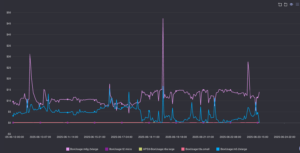DoiT now supports Google’s new mobility solutions for popular mobility use-cases such as last-mile delivery, fleet management, on-demand rides and supply-chain logistics
DoiT has just been named an official Google Maps Mobility Partner, joining a select group of approved Mobility Partners worldwide.
Urban mobility has become a major area of focus for technology firms, due to issues such as the rapid growth of cities, traffic congestion, rising fuel costs and concerns about vehicle pollution. Technological mobility solutions have emerged to help solve these issues, including electric vehicles, autonomous taxis, electric bikes and scooters and innovative forms of public transport like on-demand transport.
In parallel, the Covid pandemic led to a surge in demand for online shopping, which expanded demand for home delivery services and mobile field service teams. The recent emergence of “Quick Commerce” solutions which deliver food and groceries at lightning speeds, is a good example of this phenomenon.
With a detailed global map coverage that is continually updated, accurate street addresses, live traffic flow data and a cloud infrastructure that offers the possibility to rapidly scale, the Google Maps Platform has for many years been the API-based solution of choice for many startups in the mobility space.
With its new comprehensive Mobility Platform, Google now offers end-to-end solutions that are customizable, modular and cost-efficient, and can be provisioned and implemented at speed. Google’s mobility solutions enhance the end-user experience, improve driver operations and accurately monitor fleet performance.
After lengthy testing with select customers, Google released the following mobility solutions in early 2022, and DoiT is proud to support them:
On Demand Rides and Deliveries (ODRD)
Designed to resolve issues relating to on-demand transportation, such as taxi rides or quick food deliveries, the ODRD solution helps businesses improve operations and streamline both the driver journey and the end-customer experience, along with predictable pricing per completed trip or delivery.
Some of ODRD’s unique features include:
- The display of a driver’s ETA, expected route, and estimated trip price on a familiar Google map.
- Faster pickups and more accurate ETAs, which result in fewer canceled rides.
- In-app turn-by-turn driver navigation, which reduces the inefficiencies and distractions caused by switching from the driver app to a navigation app.
- Continuous updates available for end-customers, from booking, via pickup, to drop-off/delivery, with a real-time view of a driver’s present location, route and ETA. Traffic conditions can be shown to help contextualize changing ETAs.
- Tools and dashboards to accurately monitor fleet performance and enable further optimization.
Last Mile Fleet Solutions (LMFS)
Similar in concept to ODRD, LMFS focuses on successful execution of pre-planned deliveries and rides, with the flexibility to make changes in real time as required – also with predictable pricing per completed delivery/ride. Features include shipment tracking and up-to-date arrival times, which enable end-customers to prepare for delivery of their packages. Plus, they can be assured that their delivery will be successful because detailed delivery locations – based on Google Maps’ hyperlocal data and enhanced by StreetView images – allow drivers to deliver packages to the right place every time using enhanced in-app turn-by-turn navigation.
Cloud Fleet Routing (CFR)
The CFR API is a Google Cloud AI-based platform that integrates seamlessly with LMFS. CFR is designed to enable vehicle fleet operators to undertake fleet-wide multi-criteria route planning at scale, for both first and last mile delivery fleets. Due to the unpredictability of transport conditions, CFR enables multiple re-optimizations of routing plans in real time, allowing operators to respond rapidly to disruption and take immediate action to update end consumers.
How can organizations harness Google Maps Mobility Platform?
The Google Maps Mobility Platform has huge potential for applications in a wide range of mobility use-cases – including shared rides, taxis, last-mile delivery, fleet management and supply-chain logistics.
With increased customer demands, higher delivery expectations and escalating climate concerns, the timing could not be better for the Maps Mobility Platform. To secure and maintain a competitive advantage, businesses need to do better in terms of their customer service, logistical execution and environmental consideration.
With prudent use of new technologies such as those available from the Google Maps Mobility Platform, companies can accelerate their business impact with more efficient transportation and delivery, greater protection against supply-chain disruption and enhanced mobility. They can also ensure they are making the sustainable choices required to support a low-carbon digital economy.
Get in touch with our location-based services experts to discuss your mobility requirements and learn how the Maps Mobility Platform can help your firm navigate towards a bright mobility future.


